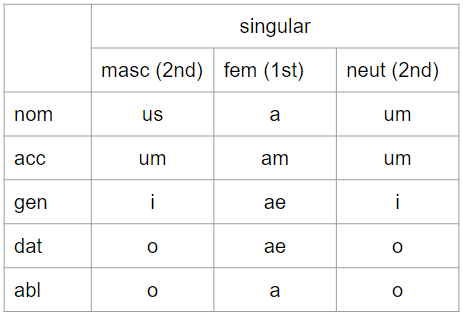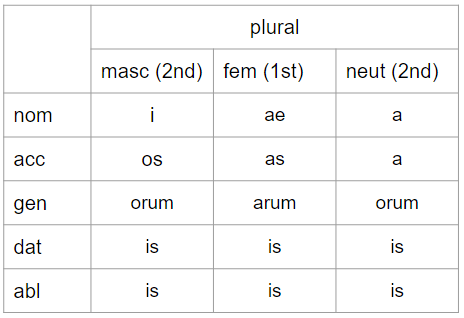Future Active Participles
What is a future participle anyway?
For this week’s post I'm going to be talking about future active participles. Welcome back to bambasbat!
Today, we're going to be looking at participles. What that means is we're going to be needing our noun endings. If you've forgotten them, don't worry, you can find my free noun endings guide here. It's got all the endings you'll need for first, second and third declension and we are going to need the first and second declensions today. So go and download that before we start, it will really help you out.
But what is a participle?
First of all, we need to know what a participle actually is. It's what's called a verbal adjective. That has two parts to it:
It is formed from a verb
It declines like an adjective.
So it has a tense because it's formed from a verb, but it also has number, gender, and case because it declines like an adjective.
What participles are there?
There are four types of participle, mainly.
The present active participle: carrying
The perfect passive participle: having been carried
The future active participle: being about to carry
The perfect active participle (which is really only for deponent verbs): having spoken.
Today we're going to be focusing on the third one of these, which is the future active participle.
If you've missed my other posts about present active and perfect passive participles, you can find them here. And I'll be doing a post about perfect active participles very soon, so make sure you are subscribed for that one.
Alright, tell me about Future Active ones
So future active participles are formed from the fourth principal part of a verb in your dictionary. So look at this verb:
porto portare portavi portatus
The fourth one is the one that we want. Take the -us ending off, and then add -ur- onto the stem. The -ur- is an extra syllable added to the fourth principal part. After that you add the correct ending to match the noun in case, number and gender.
Here are the endings that you need for future active participles:
These are the endings that go after the UR that I've attached to my perfect passive participle, and that becomes my future active participle. Those of you who are eagle eyed will have seen that they are second declension, first declension, second declension endings. They decline like a 2 1 2 adjective, so that's why you need your noun endings. So we have masculine, feminine and neuter endings. Again if you're not sure about adjectives you can find my posts about those in the bambasbat archive.
Recap
To form a future active participle:
4th principal part
Remove -us ending
Add -ur-
Add the correct ending (matching the noun in case, number and gender)
With the verb porto, to describe a masculine genitive singular noun:
portatus
portat-
portatur-
portaturi
I like to say for a futURe active participle, what's missing? U R. Like future. I think that can be helpful for remembering.
Anyway, moving on!
What are they for?
A future active participle describes an action that's about to happen at the time of the main verb.
Here’s an example:
servus laboraturus fessus erat.
laboraturus is my future active participle.
“The being-about-to-work slave was tired.”
That's a very clunky way to translate this sentence. It's absolutely correct, but it's very clunky. So I might say instead, “the slave, who was about to work, was tired”. This is a much more natural translation. In this case I've set the future participle within the context of the main verb. My main verb, erat, is an imperfect verb, “was”. “He was tired”.
That is why it is translated as “who was about to work”. At the time the main verb was happening, he was going to do this.
Here's another example.
femina magistrum vocatura cecidit.
This time I have a feminine nominative noun, which is being described by the nominative participle vocatura.
“The being about to call the teacher, woman, fell over”
This sentence is a bit silly, to be honest, but it highlights the point that my ending has to change based on my noun that I'm describing. In this case, the participle is not describing the teacher, magister. Instead it’s describing the femina. That means that it needs to use a feminine ending, to match “the woman”.
Again, this is a very clunky way to describe it, “being about to call”. So what I'm going to say is, “the woman who was about to call the teacher fell over”.
Translating these is actually a lot easier than it sounds
You just have to make it make sense in English. Make sure you get that future sense in, “being about to do something”, and make sure that it makes sense with the tense of the main verb. Don't change the tense of that main verb, you know what tense cecidit is, it is perfect, and it can't be anything else.
She fell over, past tense. The idea is, that she was just about to call the teacher, but she fell over, so possibly didn't.
So just to remind you, this is how we form future active participles. Take the fourth principal part, add the -UR- syllable, and then add the 2 1 2 endings.
That's all there really is to future active participles!
Make sure you keep that active sense when you translate it, “being about to do something” herself or himself, rather than something being done to her. It is not passive, it is an active participle.
Thanks very much for reading. I hope it's been helpful. Let me know if you have any questions in the comments.
I'll see you next time on bambasbat!



